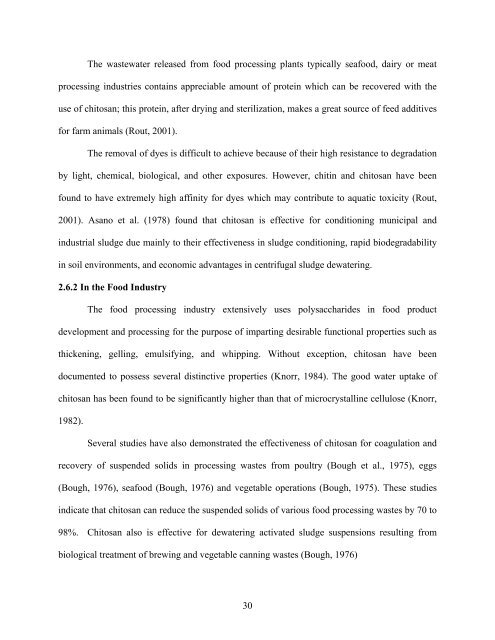physicochemical and functional properties of crawfish chitosan as ...
physicochemical and functional properties of crawfish chitosan as ...
physicochemical and functional properties of crawfish chitosan as ...
Create successful ePaper yourself
Turn your PDF publications into a flip-book with our unique Google optimized e-Paper software.
The w<strong>as</strong>tewater rele<strong>as</strong>ed from food processing plants typically seafood, dairy or meat<br />
processing industries contains appreciable amount <strong>of</strong> protein which can be recovered with the<br />
use <strong>of</strong> <strong>chitosan</strong>; this protein, after drying <strong>and</strong> sterilization, makes a great source <strong>of</strong> feed additives<br />
for farm animals (Rout, 2001).<br />
The removal <strong>of</strong> dyes is difficult to achieve because <strong>of</strong> their high resistance to degradation<br />
by light, chemical, biological, <strong>and</strong> other exposures. However, chitin <strong>and</strong> <strong>chitosan</strong> have been<br />
found to have extremely high affinity for dyes which may contribute to aquatic toxicity (Rout,<br />
2001). Asano et al. (1978) found that <strong>chitosan</strong> is effective for conditioning municipal <strong>and</strong><br />
industrial sludge due mainly to their effectiveness in sludge conditioning, rapid biodegradability<br />
in soil environments, <strong>and</strong> economic advantages in centrifugal sludge dewatering.<br />
2.6.2 In the Food Industry<br />
The food processing industry extensively uses polysaccharides in food product<br />
development <strong>and</strong> processing for the purpose <strong>of</strong> imparting desirable <strong>functional</strong> <strong>properties</strong> such <strong>as</strong><br />
thickening, gelling, emulsifying, <strong>and</strong> whipping. Without exception, <strong>chitosan</strong> have been<br />
documented to possess several distinctive <strong>properties</strong> (Knorr, 1984). The good water uptake <strong>of</strong><br />
<strong>chitosan</strong> h<strong>as</strong> been found to be significantly higher than that <strong>of</strong> microcrystalline cellulose (Knorr,<br />
1982).<br />
Several studies have also demonstrated the effectiveness <strong>of</strong> <strong>chitosan</strong> for coagulation <strong>and</strong><br />
recovery <strong>of</strong> suspended solids in processing w<strong>as</strong>tes from poultry (Bough et al., 1975), eggs<br />
(Bough, 1976), seafood (Bough, 1976) <strong>and</strong> vegetable operations (Bough, 1975). These studies<br />
indicate that <strong>chitosan</strong> can reduce the suspended solids <strong>of</strong> various food processing w<strong>as</strong>tes by 70 to<br />
98%. Chitosan also is effective for dewatering activated sludge suspensions resulting from<br />
biological treatment <strong>of</strong> brewing <strong>and</strong> vegetable canning w<strong>as</strong>tes (Bough, 1976)<br />
30

















